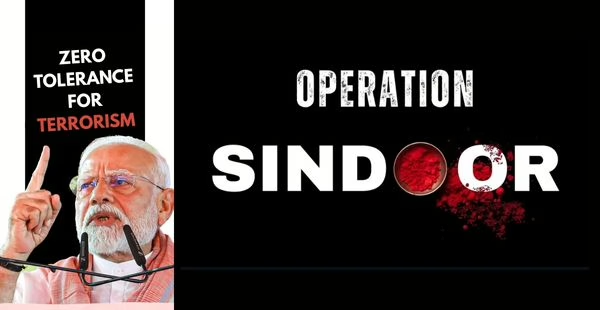
On May 7, 2025, India launched a significant military operation codenamed “Operation Sindoor,” a meticulously planned and executed response to a devastating terrorist attack in Pahalgam, Jammu and Kashmir, that claimed 26 lives on April 22, 2025. This unprecedented strike, involving coordinated efforts by the Indian Army, Navy, and Air Force, targeted nine terrorist infrastructure sites in Pakistan and Pakistan-occupied Kashmir (PoK).
Named after “sindoor” — a symbol of both marital devotion and warrior pride in Indian culture — the operation was not only a tactical triumph but also a deeply symbolic one. The Sindoor meaning in Operation Sindoor transcended its literal interpretation, standing for national honor, sacrifice, and a pledge for retribution. This blog explores the context, execution, symbolism, and geopolitical impact of Indian Army Operation Sindoor, reflecting on its broader implications.
The Trigger: The Pahalgam Terror Attack
The catalyst for Operation Sindoor was the brutal terrorist attack in Pahalgam, a scenic haven in Jammu and Kashmir. On April 22, 2025, heavily armed terrorists stormed a civilian area, murdering 25 Indian citizens and one Nepali tourist. Among the victims was Lieutenant Vinay Narwal of the Indian Navy, who was honeymooning with his wife, Himanshi Narwal — married just six days prior. His martyrdom became a heart-wrenching national moment, with the image of Himanshi crying beside his body encapsulating the tragedy.
Investigations linked the attack to Pakistan-based terror outfits, including Lashkar-e-Taiba and The Resistance Front. The brutality of the assault, where Hindu men were reportedly executed at close range, outraged the nation. Prime Minister Narendra Modi vowed swift retribution, promising that the perpetrators and their backers would face consequences beyond rhetoric.
Planning and Execution: A Tri-Services Triumph
Indian Army Operation Sindoor marked the first tri-services operation since the 1971 war. In a pre-dawn assault launched at 1:44 AM on May 7, 2025, the Indian Armed Forces hit nine terror training camps in Pakistan and PoK. Among the high-value targets were Lashkar-e-Taiba’s headquarters in Muridke and Jaish-e-Mohammed’s facilities in Bahawalpur.
Key highlights included:
-
Precision weapons like SCALP cruise missiles, Hammer Smart Bombs, and loitering munitions.
-
Strikes executed from Indian territory using beyond-visual-range weapons, ensuring pilot safety.
-
Intelligence inputs by RAW and strategic coordination overseen by NSA Ajit Doval.
-
Real-time updates received by PM Modi from his residence.
-
Clear avoidance of Pakistani military targets to prevent escalation.
The Air Force, Navy, and ground forces displayed seamless coordination. No Indian aircraft were lost, and the operation achieved its objectives with zero collateral civilian casualties — underscoring the surgical nature of the mission.
The Cultural and Strategic Significance of “Sindoor”
To understand the Sindoor significance in Operation Sindoor, one must delve into its dual meaning in Indian tradition. Sindoor (vermilion) is applied by Hindu women as a symbol of marriage, representing their husbands’ life and protection. It is also worn by warriors as a tilak before heading into battle, symbolizing strength, honor, and readiness for sacrifice.
By naming the mission Operation Sindoor, India paid homage to the deeply personal losses suffered in Pahalgam — especially those of newlyweds like Lieutenant Narwal and his wife. It was a statement that every life lost would be remembered and avenged with honor. The operation’s name evoked both grief and determination, serving as a rallying cry for justice and national pride.
A powerful sindoor-themed graphic shared by the Indian Army on X (formerly Twitter) further solidified the emotional and psychological impact of the mission. As Sindoor meaning in Operation Sindoor began trending, millions resonated with the symbolism, uniting the nation in support of the military’s actions.
Diplomatic and Regional Fallout
Operation Sindoor quickly reshaped regional geopolitics. Pakistan labeled the strikes as an “act of war,” while India clarified they were “non-escalatory and targeted only at terror infrastructure.” Pakistani Prime Minister Shehbaz Sharif threatened retaliation, and the Pakistani military reported civilian casualties — a claim India rejected, stating all intelligence-backed targets were directly linked to terrorism.
India’s diplomatic outreach was swift and strategic:
-
NSA Ajit Doval briefed U.S. Secretary of State Marco Rubio.
-
The Indian Embassy in Washington presented evidence linking Pakistan to the Pahalgam attack.
-
UN Secretary-General António Guterres urged restraint but refrained from condemning India.
-
The UN Security Council convened but issued no official statement.
India also took significant policy steps:
-
Suspension of the Indus Waters Treaty.
-
Downgrading diplomatic ties with Pakistan.
-
Activation of civil defense drills in over 240 districts.
-
Heightened alert along the Line of Control (LoC), and closure of border-area schools and airports.
These measures illustrated India’s readiness for escalation, without losing focus on Justice for Pahalgam victims.
National Response and Women in Uniform
The Indian public responded with overwhelming support. Slogans like “Indian Army Zindabad” and “Bharat Mata ki Jai” echoed across cities and border towns. Social media was flooded with emotional tributes to the armed forces and viral posts honoring the victims.
Political unity was also evident. Defence Minister Rajnath Singh, Congress leader Rahul Gandhi, and others lauded the operation. For the grieving families, Operation Sindoor offered a sense of closure. Shubham Dwivedi’s widow expressed public gratitude, stating that justice had been delivered to her husband’s soul.
A historic moment came during the official press briefing. Colonel Sofiya Qureshi and Wing Commander Vyomika Singh — both women — stood alongside Foreign Secretary Vikram Misri to explain the operational strategy and intelligence rationale. Their presence underscored India’s evolving military ethos, where women are now leading from the front.
Strategic Implications and Future Outlook
Operation Sindoor represents a paradigm shift in India’s counter-terrorism strategy. While earlier responses like the 2016 surgical strikes and 2019 Balakot airstrike were significant, this mission was larger in scope, multi-domain in execution, and unprecedented in joint-force coordination.
Key takeaways include:
-
India’s capability to carry out complex precision strikes with minimal risk.
-
Enhanced use of real-time intelligence and advanced munitions.
-
Improved civil-military coordination for rapid deployment and decision-making.
Yet, the road ahead is complex. Pakistan’s vow to retaliate, ongoing skirmishes along the LoC, and international pressure for de-escalation require a calibrated approach. Indian intelligence agencies warn of possible retaliatory terror attempts, urging continued vigilance.
Domestically, the operation boosts the Modi government’s image as a protector of national security. But long-term peace in Kashmir will require developmental, political, and societal engagement beyond military solutions.
Conclusion
Operation Sindoor was not just a retaliatory strike—it was a national catharsis. By combining cultural symbolism with military precision, India delivered a powerful message: terrorism will not go unanswered. The Sindoor significance in Operation Sindoor lies in its power to evoke the personal within the political, and the sacred within the strategic.
Through this tri-services operation, India avenged its fallen, upheld its sovereignty, and asserted its right to self-defense. For a nation grieving the victims of the Pahalgam massacre, this mission was a step toward healing, justice, and unity.
As declared in the final statement by the Indian Army:

